As a homeowner constantly searching for avenues to enhance my living space while being kind to my wallet, I’ve discovered that investing in energy-efficient home improvements stands out as one of the smartest decisions one can make. Whether it’s about lowering the energy bill or doing my part for the environment, the pursuit of energy efficiency has become more than just a trend; it’s a necessity.
Key Takeaways
- Boosting energy efficiency at home is a strategic move with both environmental and financial benefits.
- Energy audit is a starting point to identify how to effectively reduce energy waste.
- Energy-efficient upgrades can lead to substantial energy savings and might qualify for tax credits.
- The Inflation Reduction Act offers an opportunity for homeowners to claim energy efficient home improvement credit.
- Undertaking efficiency upgrades not only helps to save energy but also increases the market value of your home.
- Simple home improvements can cumulatively reduce your energy bills and enhance the comfort of your living space.
Top 9 Home Upgrades To Save Money Now
Here is a list for 9 cost-effective energy-saving home improvements that can help now:
- Insulate water heater
- Statistics: Can save $30-45 per year
- Description: Add an insulating jacket to your hot water heater for $30-40. This can be installed in about an hour and will help reduce standby heat losses.
- Install smart thermostat
- Statistics: Can reduce heating/cooling costs by 8-15%
- Description: Smart thermostats can optimize heating and cooling cycles and help save on energy bills. They cost roughly $200.
- Switch to LED lightbulbs
- Statistics: Use at least 75% less energy and last 25x longer than incandescents
- Description: Although more expensive upfront, LEDs save about $50 over their lifespan in energy costs compared to incandescent bulbs.
- Insulate water pipes
- Statistics: Can reduce water heating costs by 4-17%
- Description: Insulating exposed hot water pipes reduces standby losses as hot water travels to fixtures. DIY foam sleeves cost around $20.
- Install ceiling fans
- Statistics: Can reduce AC costs by up to 40%
- Description: Energy efficient ceiling fans optimize air circulation and allow raising the thermostat setpoint in summer. Cost is $120-300.
- Upgrade refrigerator
- Statistics: New Energy Star models use at least 15% less energy than non-certified models
- Description: By replacing refrigerators older than 10 years, you can save $270 over the lifetime of a new Energy Star model.
- Add attic insulation
- Statistics: Properly insulated attics can reduce heating/cooling costs by 10-50%
- Description: Most homes require at least R-38 attic insulation. Costs vary based on climate and house size.
- Caulk and weatherstrip
- Statistics: Can reduce total home energy costs by up to 20%
- Description: Sealing uncontrolled air leaks with caulk and weatherstripping costs about $20 in materials. Lower energy costs continue for the life of the home.
- Install a smart power strip
- Statistics: Can reduce standby power waste by up to 75%
- Description: Smart strips sense when devices are in standby mode and cut power automatically. This prevents wasted standby loads from devices that are plugged in but turned off.
Attic Insulation – The Starting Point for Energy Savings
When aiming to enhance home energy efficiency and reduce energy consumption, many homeowners overlook a critical component: their attic. Proper attic insulation is a foundational upgrade that contributes significantly to an energy-efficient home. Not only does it help maintain a consistent temperature throughout your living spaces, but it also offers substantial cost savings on your energy bill.
ENERGY STAR emphasizes air sealing and insulation as the most cost-effective way to improve efficiency and comfort in your home, significantly reducing energy bills and environmental impact.
Before choosing the right insulation for your attic, it’s essential to understand the types of materials available and their respective R-values—an indicator of the material’s ability to resist heat flow. Higher R-values translate into more effective insulation and, consequently, greater energy savings.
Understanding Insulation Materials and R-Values
Among the options, you’ll find fiberglass, cellulose, and foam—each with its unique properties and R-values. Let’s take fiberglass, for instance, popular for its fire resistance and ease of installation. When considering a depth of 12 inches, fiberglass offers an R-value that can immensely improve your home’s energy savings. To make an informed decision, contemplate how each material will interact with your specific home environment.
Maximizing Tax Credits for Insulation Upgrades
An added incentive for upgrading your attic insulation is the potential for tax credits. Various programs, including those initiated by the Department of Energy, provide financial benefits for homeowners who choose to make energy improvements. For instance, the Energy Star program rewards energy-efficient upgrades that meet specific criteria.
| Material | Approximate Cost | R-Value (per inch) | Key Benefit |
|---|---|---|---|
| Fiberglass | $0.30 – $0.40 per sq. ft. | 2.2 – 2.7 | Fire Resistant |
| Cellulose | $0.30 – $0.45 per sq. ft. | 3.2 – 3.8 | Eco-Friendly |
| Foam | $0.50 – $2.25 per sq. ft. | 3.6 – 8.0 | High Insulating Power |
I encourage you, as a homeowner looking to upgrade your energy cost-efficiency, to research available tax credits further and take advantage of this financial aid. Investing in high-quality attic insulation has never been more attainable and economical. Not only will it lower your energy costs, it will also play a significant role in boosting overall home energy efficiency.
Storm Windows – Shielding Your Home from Energy Loss
As a homeowner keen on reducing energy consumption and energy cost, I’ve discovered that installing storm windows is a transformative home improvement. These additional window panes act as a barrier against the elements, particularly useful in older homes where drafty windows can lead to significant energy loss.
It’s easy to overlook the benefits of storm windows when considering energy-efficient upgrades, but the statistics speak for themselves. These marvels of energy efficiency can save energy by minimizing the workload on heating and cooling systems. The layer of insulation they add means our systems don’t have to work as hard to maintain a comfortable indoor temperature. The result? A noticeable decrease in our energy bills.
Let’s break down the savings:
| Upgrade | Initial Cost | Energy Savings | Payback Period |
|---|---|---|---|
| Basic Storm Windows | Starting at $50/window | Reduce heat loss by up to 10% | Varies based on number of windows and climate |
| Low-E Storm Windows | Higher initial cost | Up to 30% heating and cooling savings | Generally within a few years |
Investing in storm windows with low-emissivity (low-e) glass is particularly impactful. They block UV rays and further lower energy costs, a pragmatic choice for those looking to upgrade their home to the pinnacle of efficiency. Furthermore, the aesthetic neutrality of storm windows means we don’t have to sacrifice the charm of our homes for the sake of energy efficiency.
By fortifying our homes against heat and cool air loss, we instill a year-round resilience that culminates in both financial and environmental benefits.
In conclusion, the quest for a more energy-efficient home often leads to complex solutions, but the simplicity of installing storm windows rewrites the narrative. It’s a practical step for making our homes comfortable and cost-effective—the type of energy-efficient home improvements that yield dividends in comfort and lower energy costs.
Exterior Caulking and Weatherstripping – Sealing the Gaps
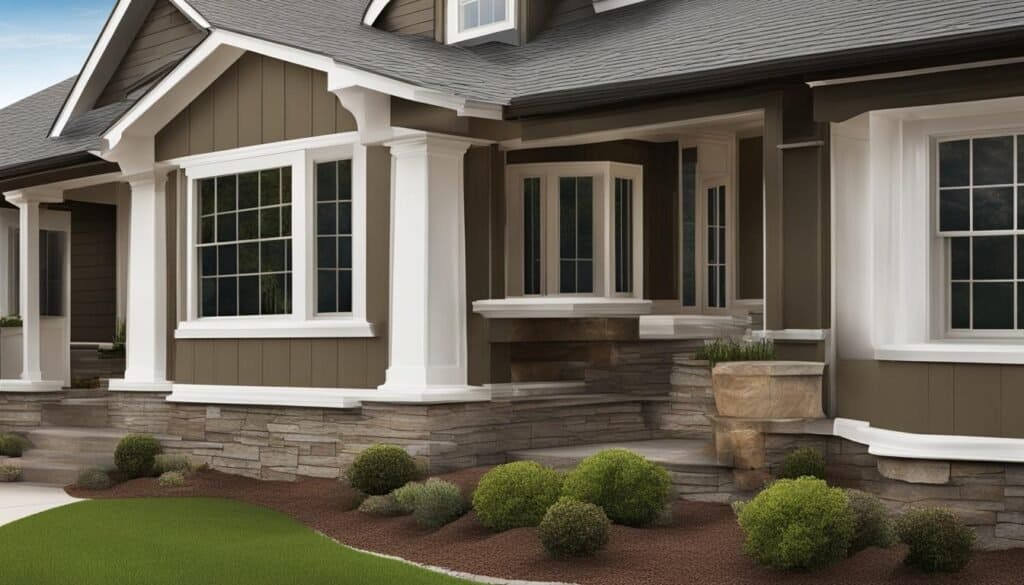
As I take measures to enhance the energy efficiency in my home, I’ve discovered that addressing the often-overlooked cracks and openings around doors and windows can lead to considerable energy savings. Applying exterior caulking and installing new weatherstripping are cost-effective upgrades that help to mitigate energy waste by sealing those pesky gaps. Not only does this reduce energy costs, but it also bolsters overall home energy performance.
Before diving into the how-to, let’s clarify why these simple steps make such a big difference. Minor gaps might seem trivial, but they can add up to the equivalent of leaving a window open year-round. That means your heating and cooling systems have to work overtime, thus increasing your energy bill unnecessarily. By sealing these gaps, we’re maintaining a home that’s more comfortable and energy-efficient—a win-win in the realm of home improvement.
Choosing the Right Caulking for Your Home
When it comes to caulking, selecting the right type is imperative for creating lasting seals. Silicone caulk is a popular choice due to its flexibility and resilience to temperature changes, making it ideal for exterior use. It adheres well to a variety of surfaces and withstands weather elements, ensuring that the sealing does its job effectively and efficiently.
Weatherstripping Materials: Which is Right for You?
Similarly, weatherstripping materials vary in durability and suitability for different areas of the home. For areas subject to a lot of movement and friction, such as windows and doors, vinyl or metal weatherstripping provides a durable and energy-efficient solution. These materials can help to tightly seal movable joints and reduce energy leakage remarkably.
| Material Type | Recommended Use | Durability | Cost-effectiveness |
|---|---|---|---|
| Silicone Caulk | Exterior gaps and cracks | High | High |
| Vinyl Weatherstripping | Windows and doors | Medium to High | Medium |
| Metal Weatherstripping | Doors and operable windows | High | High |
Investing in the right exterior caulking and weatherstripping doesn’t just reduce energy bills—it’s also a proactive approach to enhancing home comfort. Such energy-efficient upgrades can quickly pay for themselves by the amount of energy saved, making them essential elements of any smart home improvement plan focused on sealing and insulation. Remember, preventing air leakage is a crucial step in achieving optimal energy efficiency in our homes.
LED Lighting – Brightening Your Home Efficiently
When considering home improvement strategies with a focus on reducing energy consumption and cutting down the energy bill, I often encourage investing in LED lighting. Not only do these energy-efficient light solutions contribute to remarkable energy savings, but they also align with energy-efficient home upgrades that are currently shaping the market. As a homeowner, the decision to save energy and reduce your energy footprint can start with a simple upgrade to light bulbs that carry the Energy Star certification.
My personal experience with swapping out conventional lighting for LEDs has proven not only cost-effective but sensible from an ecological standpoint. Despite higher upfront costs compared to traditional incandescent bulbs, the long-term benefits cannot be overstated. With a life expectancy of up to 50,000 hours, these bulbs outshine and outlast their counterparts, ensuring that the initial investment pays off. To illustrate, consider the following comparison between incandescent bulbs and LED alternatives:
| Lighting Type | Lifespan | Electricity Usage | Expected Energy Savings |
|---|---|---|---|
| Standard Incandescent Bulb | 1,200 hours | 60 watts | Minimal |
| LED Bulb (40W Equivalent) | 50,000 hours | 8 watts | Significant |
The superiority of LED lighting when it comes to enhancing home energy efficiency is clear to me as it should be to any eco-conscious homeowner looking to perform energy-efficient home upgrades. The transition to LED bulbs not only promises to save energy but also contributes to a better living environment within our homes, demonstrating that conscientious choices can indeed make a quantifiable difference in our day-to-day lives.
Smart Home Technology – Intelligent Cost-Effective Energy-Saving Home Improvements
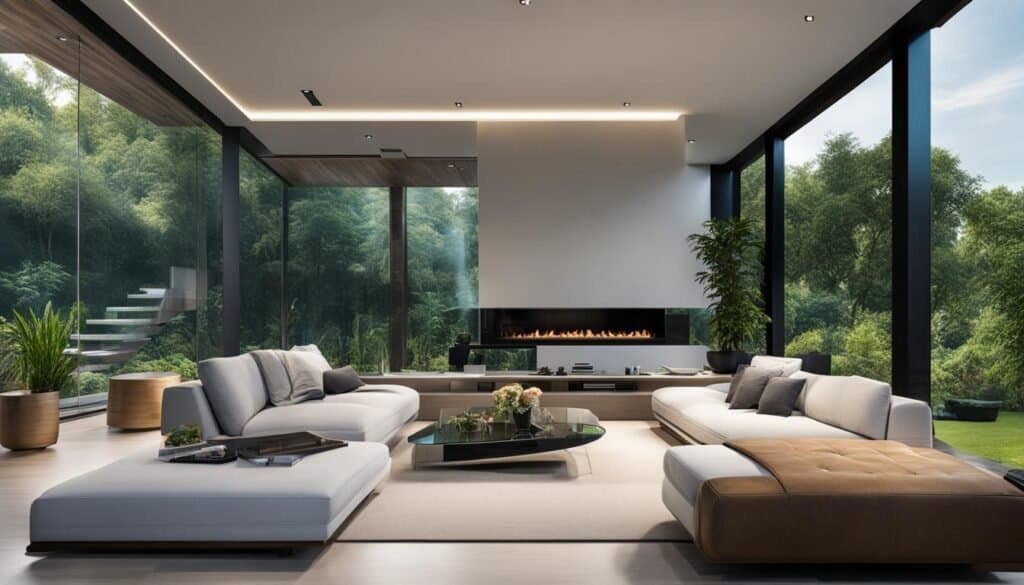
Advancing my home upgrade with smart home technology was an enlightening experience. I witnessed firsthand how integrating smart thermostats and other devices heightened my home’s energy efficiency substantially. It’s more than just a convenience—it’s an investment in future savings and comfort.
How Smart Thermostats Save You Money
Since I installed a smart thermostat, the changes in energy use have been substantial. These programmable thermostats adjust the temperature based on my daily routines and can be controlled from anywhere, thus ensuring I only heat or cool my home when necessary. By analyzing my usage patterns and adjusting accordingly, my energy bill has seen a noticeable decrease—an achievement I credit to this clever addition to my home improvement arsenal.
Integrating Smart Home Devices for Maximum Energy Efficiency
Smart thermostats were just the beginning. By creating a network of interconnected smart home devices, energy savings reached even greater heights. From lights that switch off when no one is in the room, to energy-efficient appliances that operate at the most cost-effective times, every addition is a step towards a sustainably smart home.
| Smart Device | Energy Savings Feature | Expected Impact on Energy Bill |
|---|---|---|
| Smart Thermostats | Remote temperature control and scheduling | Reduces heating and cooling costs significantly |
| Smart Lights | Motion activation and automatic dimming | Avoids unnecessary energy use; subtle but steady cost decrease |
| Smart Plugs | Programmable operations for appliances | Ensures off-peak operation for energy cost savings |
| Smart Appliances | Optimized energy consumption | Enhances overall energy efficiency within the home |
As I embraced each innovative device, the collective impact of these energy-efficient home improvements became undeniably clear. My journey with smart home technology not only brought about substantial energy savings but also transformed my space into a savvy, self-regulating haven.
Air Duct Maintenance – Keeping Your Home’s Lungs Healthy
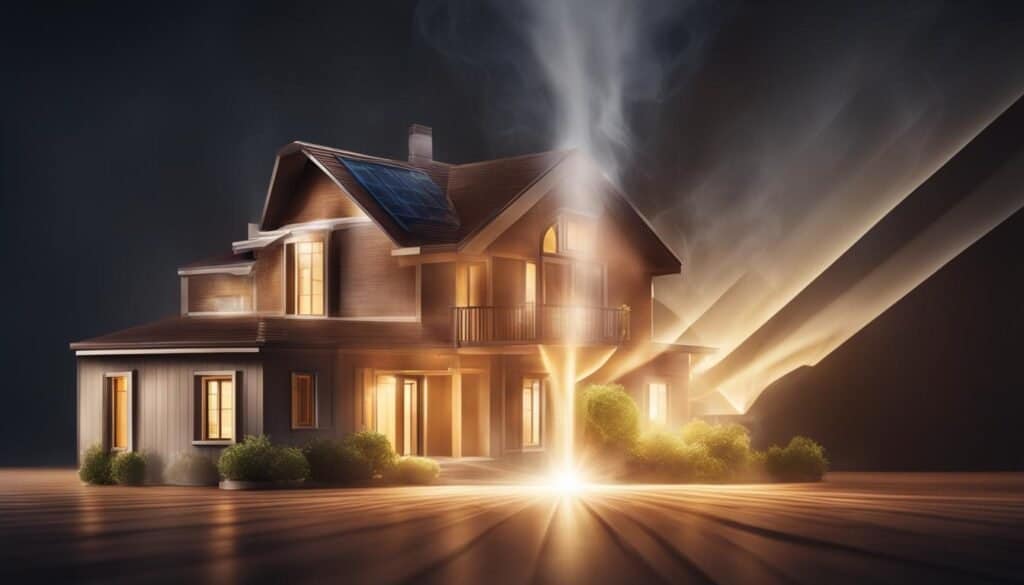
When it comes to heating and cooling your home, the efficiency of your HVAC system hinges on a critical, yet often overlooked aspect: air duct maintenance. Investing in this home improvement not only secures energy savings but prevents energy waste, ensuring every dollar on your energy bill is well spent. By choosing professional duct sealing as part of your energy-efficient upgrades, you can expect to save energy that otherwise slips away unseen.
As a homeowner keen on both home energy conservation and cost-saving, I understand that energy consumption is a sizable component of monthly expenses. Let me show you how proper air duct maintenance can transform your property into an energy-efficient home. Reflect on the following significant advantages duct maintenance provides:
- Diminished heat and cool air loss through duct leaks
- Increased efficiency of your entire HVAC system
- Improved air quality and circulation within your home
Up to 40% of heated or cooled air can be lost to duct leaks, leading to unnecessary energy use and increased costs.
Confronting the issue head-on with a home energy upgrade such as duct sealing can lead to tangible energy savings. While the initial estimate of around $750 may seem steep, the reduction in energy consumption translates to sizeable savings over time.
| Factors | Impact on Home Energy |
|---|---|
| Unsealed Ducts | Up to 40% loss of air |
| Professional Duct Sealing | Savings on energy consumption |
| Payoff Period | Less than 2 years |
| Indoor Air Quality | Improved after sealing |
By proactively adopting energy-efficient home improvements, such as duct maintenance, you not only upgraded your home’s functionality but also pivot towards a robust, cost-effective home energy system.
Outdoor Laundry Lines – Renewable Energy for Your Clothes
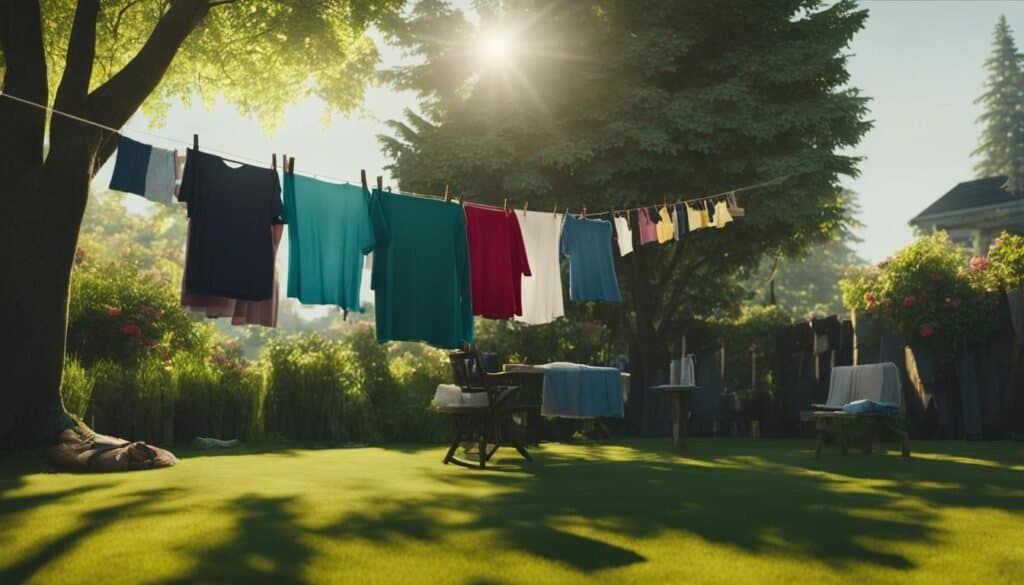
As I embrace home improvement, I’m always on the lookout for energy-efficient solutions that don’t just ease the strain on my energy bill, but also have a positive impact on the environment. That’s when I turned my eyes towards an eco-friendly classic: outdoor laundry lines. It’s a truly cost-effective upgrade in my journey towards creating an energy-efficient home, and it delivers tangible energy savings.
The Unexpected Benefit of Sun-Dried Fabrics
There’s a delightful perk to using outdoor laundry lines that goes beyond saving energy—it’s the fresh scent and the natural bleaching effect the sun imparts on fabrics. This renewable energy source not only reduces my dependence on electric or gas dryers but also helps my clothes last longer. It’s an easy answer to cutting down energy waste without sacrificing the comfort of soft, freshly laundered clothes.
Reducing Appliance Energy Use with Old-School Methods
In my effort to adopt more energy-efficient appliances and curb energy consumption, I’ve discovered that sometimes, the simplest home upgrades can be the most effective. Swapping the dryer for a stretch of rope and a handful of clothespins can shrink your energy cost and let you bask in the benefits of renewable energy. The energy-efficient initiative of harnessing the power of the wind and the sun positions my home as a model for savings and sustainability—truly an effort towards energy-efficient home improvements.
While not all days are suited for outdoor drying, whenever possible, I opt for this method. The cumulative impact on my energy bill is noticeable, and the satisfaction of utilizing natural resources is rewarding. In the age of constant technological advancement and appliance upgrades, it’s empowering to know that something as simple as an outdoor clothesline can contribute so handsomely to the goal of sustainable living.
Reflective Window Films – Control Solar Heat Gain
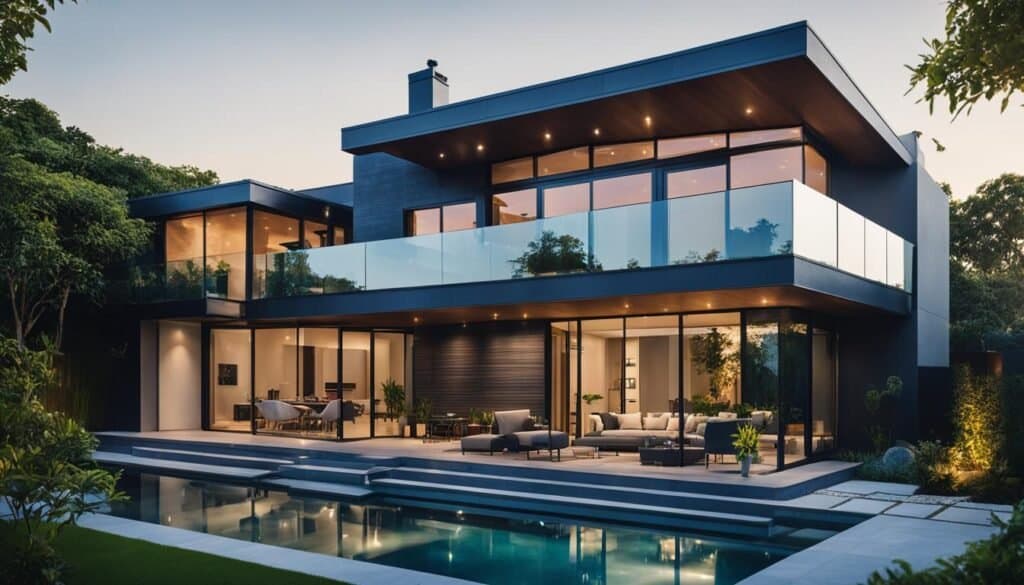
When considering energy-efficient upgrades for your home, do not underestimate the power of reflective window films. These innovative films are a game-changer in thwarting solar heat gain, which can significantly lower your energy bill and energy cost. Another advantage is the simplicity of implementation – they can be applied directly to your existing windows.
During the peak summer months, the sun’s rays can increase the temperature inside your home, forcing your air conditioning system to work overtime. This increased load not only racks up your energy bill but can lead to premature wear and tear on your HVAC system. By investing in reflective window films, you create a more comfortable indoor environment while reducing energy consumption.
Let’s break down how these home improvement marvels work. The window films consist of a metallic layer that reflects sunlight away from your interior spaces. This means that the sun’s heat and glare are significantly reduced, helping to save energy and protect your furniture from fading. It’s a straightforward upgrade that can make a big difference, especially for those south-facing windows that get the brunt of the sun’s rays.
| Benefits | Cost Savings | Comfort Improvement |
|---|---|---|
| Reduces solar heat gain | Decreases energy bill | Maintains even indoor temperatures |
| Protects against UV rays | Eliminates need for costly upgrades | Reduces glare and eye strain |
| Easy to install on existing windows | Only about $25 per roll | Enhances privacy during the day |
Reflective films are not just about keeping your home cooler; they also contribute to energy savings by reducing the need for artificial lighting. The natural light that filters in through the film is pleasant and sufficient for daytime activities without the harshness. By combining the dual benefits of light management and temperature control, these window films represent an optimal home improvement choice for anyone looking to save energy and make their home more enjoyable.
- Reduced energy usage from air conditioning
- Less dependence on artificial lighting
- Contribution to a smaller carbon footprint
To sum up, the application of reflective window films is a savvy way to reduce energy consumption and achieve energy savings. It’s a cost-effective method that enhances energy efficiency and is a brilliant addition to any energy-efficient upgrades you’re planning. Whether you’re looking to improve comfort, lower costs, or simply add a protective layer to your energy-efficient windows, window films are a stellar choice that aligns with modern home improvement trends.
Conclusion on Cost-effective Energy-saving Home Improvements
Embarking on energy-efficient home improvements is more than a quest for cost-effectiveness; it’s a strategic investment in sustainability and long-term savings. Attic insulation, storm windows, smart technologies—each of these energy-efficient upgrades holds the potential to significantly lower energy bills and enhance the comfort of my home. Bridging the initial investment with remarkable energy bill savings, these improvements have reshaped the way I manage my household’s energy consumption.
Empowering Homeowners with Cost-Effective Choices
As a homeowner, I’m conscious of the importance of cost-effective decisions. With the implementation of home energy rating systems and savvy upgrades, I’ve seen firsthand how investing in a more energy-efficient home pays dividends, touching my life daily through reduced energy costs. Not to forget the promising incentives like tax credits and rebates driven by policies like the Inflation Reduction Act, which serve to sweeten this forward-thinking shift towards green homes. The journey to augmenting my residence with energy-efficient appliances and solutions advocacy for a sustainable future while simultaneously safeguarding my finances.
Gauging the Impact of Energy Upgrades on Home Value
An energy audit was my first step toward understanding where my home stood on the energy efficiency scale. Post-upgrade, not only did I witness energy bill savings and enhanced living comfort, but these energy-efficient home improvements also boosted the market value of my property—a win-win scenario. In this green-driven market, adding such upgrades can be a determinant for potential buyers, ultimately allowing me to not just save money but also be strategically poised if I decide to sell my home. Clearly, laying the groundwork for energy efficiency is an astute move with multifaceted benefits.
FAQ on Energy Efficient Upgrades
Q: What are the most cost-effective energy-efficient home improvements?
A: The most cost-effective energy-efficient home improvements include upgrading your home with energy-efficient lighting, installing a smart thermostat, improving insulation throughout your home, using energy star certified appliances, and installing a solar water heater. Making these energy-efficient upgrades can significantly reduce your home’s energy consumption and help you save money on energy bills.
Q: How can a water heater make your home more energy-efficient?
A: Replacing your old water heater with an energy star certified model can significantly improve your home’s energy efficiency. These heaters use less energy to heat water and can result in substantial savings on your energy bills. Additionally, using a solar water heater can further reduce your reliance on fossil fuels and provide additional energy savings.
Q: How can I make my existing home more energy-efficient?
A: You can make your existing home more energy-efficient by implementing specific home energy improvements. These may include replacing old appliances with energy star certified ones, installing double-glazed windows, adding insulation, and upgrading your heating and cooling system. Also, using solar energy to power your home can drastically reduce your energy consumption.
Q: Can energy-efficient home improvements increase my home’s value?
A: Yes, making energy-efficient home upgrades can significantly increase your home’s value. When you make your home more energy-efficient, you reduce its operating costs, making it more attractive to prospective buyers. According to Energy Star, 9 out of 10 Americans would choose to buy a home with energy-efficient features if given the option.
Q: Can energy-efficient upgrades for your home result in tax savings?
A: Yes, certain energy-efficient home upgrades may qualify for federal tax credits. These credits can help offset the cost of your energy improvements, making them even more cost-effective. However, not all energy efficiency upgrades qualify for these credits, so it’s essential to check before implementing.
Q: How can energy-efficient lighting reduce my home energy consumption?
A: Energy-efficient lighting such as LED or CFL bulbs uses significantly less energy than traditional incandescent bulbs. As lighting accounts for a considerable portion of home energy use, upgrading to energy-efficient lighting can result in significant energy and cost savings throughout your home.
Q: Are there any specific energy-efficient home improvement ideas that also offer a good return on investment?
A: Yes, certain home improvements that also make your home more energy-efficient can offer a good return on investment. These include upgrading your insulation, replacing your windows with energy-efficient models, and installing a programmable thermostat. Additionally, home upgrades that pay off in the long run often include solar panel installation.
Q: How can I improve my home’s water heater efficiency?
A: There are several ways to improve your home’s water heater efficiency. You could insulate your water heater and pipes, use less hot water, or upgrade to a tankless or solar water heater. These improvements can result in increased energy savings and help make your home more energy-efficient.
Q: What benefits come from energy-efficient home upgrades?
A: Energy-efficient home upgrades come with various benefits. These may include lower household energy use, decreased energy bills, improved comfort, increase in property value, and potential tax credits. Also, these improvements can result in a reduced environmental impact by using less energy.
Q: How can solar energy improve home energy efficiency?
A: Solar energy is a renewable source that can significantly improve home energy efficiency. By installing solar panels, you can generate your own electricity and potentially sell surplus back to the grid. This not only reduces your energy usage but can also lead to substantial savings on your energy bills, making your home more energy-efficient in the process.

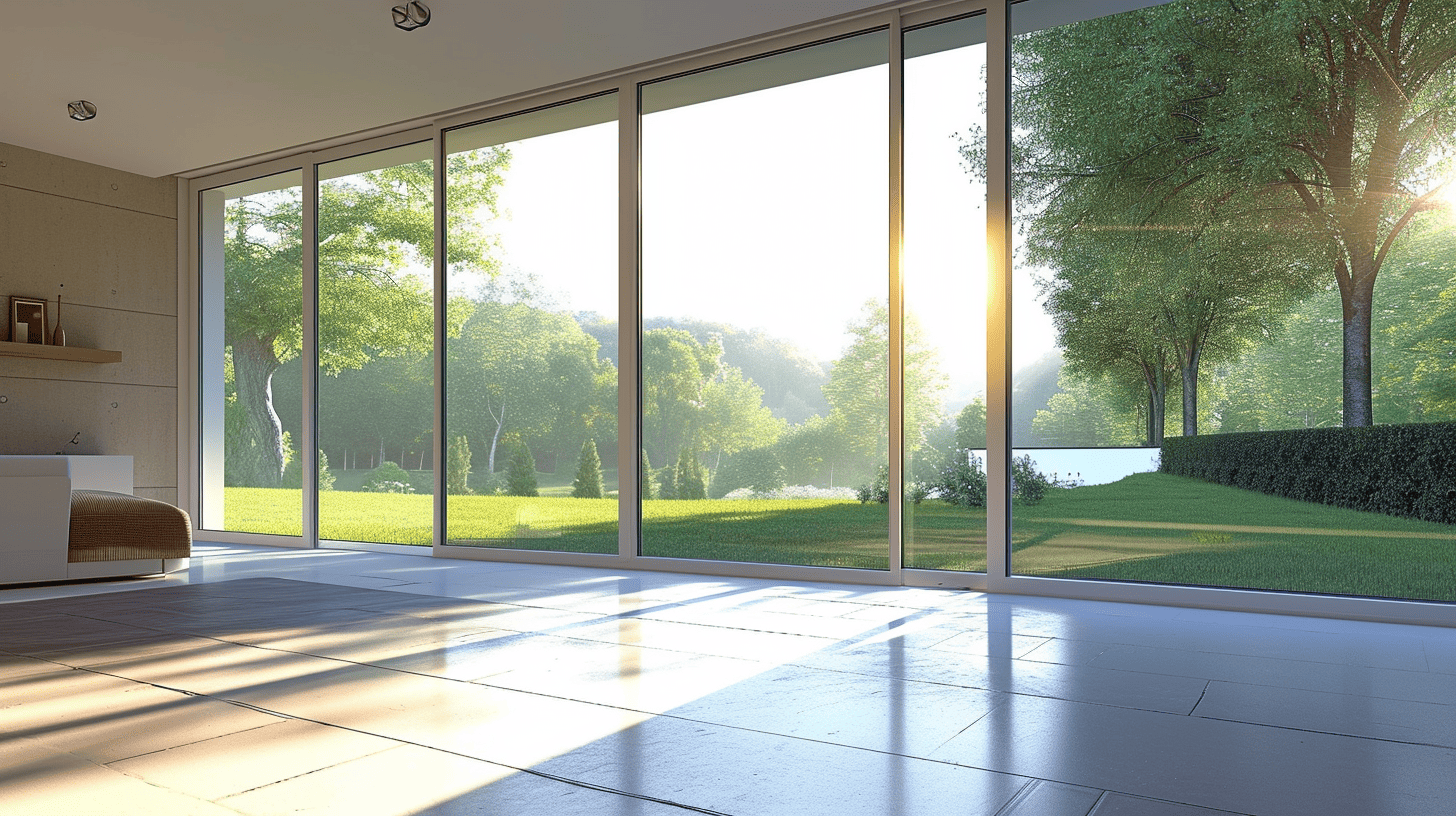



Leave a Reply